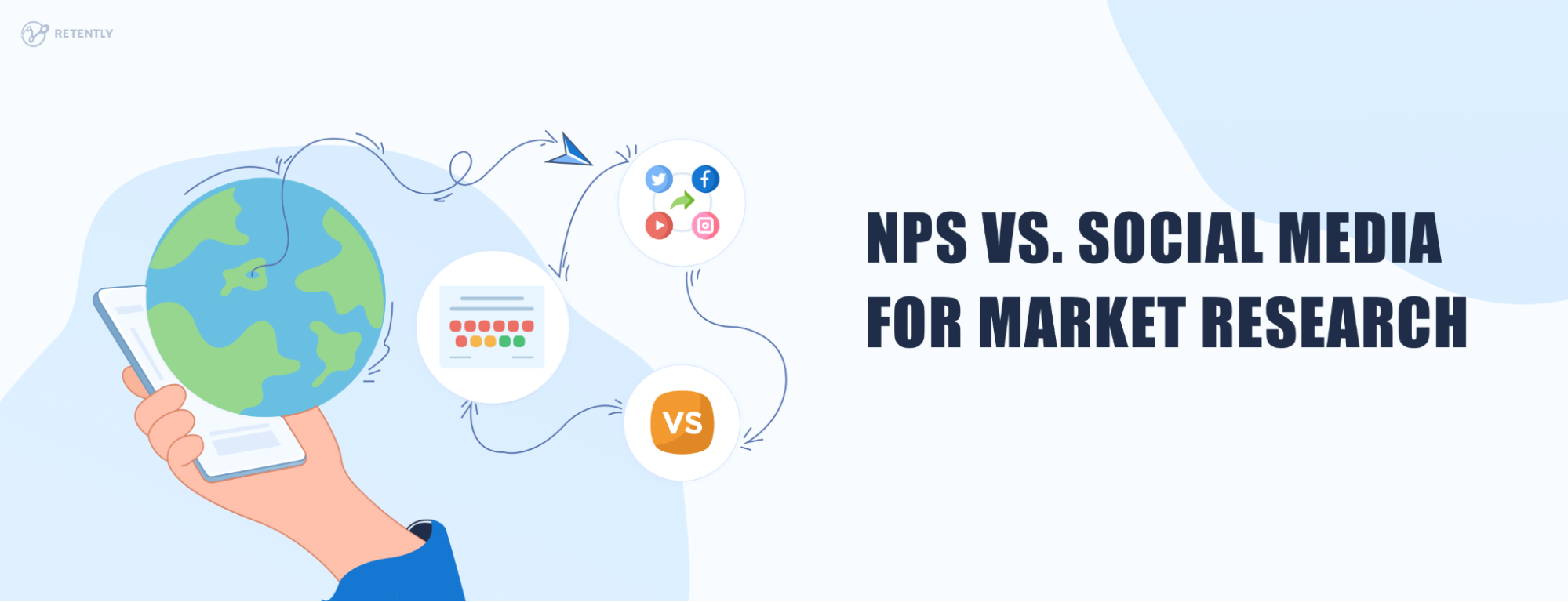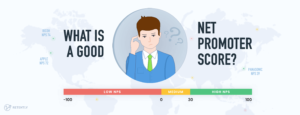Table of Contents
- Key Takeaways
- NPS Measures Customer Satisfaction, Not Public Opinion
- Social Media Can Measure Brand Awareness, But Not Results
- Social Media Success Doesn’t Always Mean Growth
- Combine NPS and Social Media for Comprehensive Market Research
- Pay Attention to Social Media, But Focus on NPS
- Start Calculating Your Net Promoter Score With Retently
One of the most common questions we receive, as an NPS®-focused software business, is how Net Promoter Score® differs from the type of data you can extract by studying people’s reactions on social media platforms like Facebook, Twitter and Instagram.
This is an easy question to answer, although one that’s best tackled in detail.
Discussion on social media platforms like Facebook and Twitter can be a powerful, accurate and valuable signal of public opinion, whether aimed at a business, an event or an individual.
In fact, social media is such a sensitive barometer of public opinion that during the presidential election, branding experts speculated that social media could be a more valuable platform for market research than traditional advertising.
It’s a statement that many, if not most, people in tech would probably agree with. Social media has immense value for market research, both from the perspective of providing a large-scale view of public opinion and granting marketers a telescopic level of detail.
But is social media an accurate indicator of whether or not real, paying customers are satisfied with a brand? Maybe not.
Below, we’ve explained how Net Promoter Score and social media reactions differ as market research tools, as well as how these two data sources can be used together to help your business grow.
Key Takeaways
- NPS provides targeted insights into customer satisfaction, while social media offers a general view of public sentiment, which may not reflect true customer loyalty.
- NPS delivers actionable insights to improve customer retention and reduce churn, while social media primarily measures brand awareness and general public opinion.
- Using both NPS and social media enables companies to identify specific issues, test new ideas, and adapt to trends for better decision-making and growth.
NPS Measures Customer Satisfaction, Not Public Opinion
The biggest difference between NPS and social media sentiment is that one measures how paying customers feel about your product, while the other reckons (albeit, imprecisely) the way the general public feels about your product.
As any entrepreneur or marketer knows, public sentiment isn’t always a good reflection of a product or brand’s potential. Ask people whether or not they’d like to use your product before you launch and you’ll hear one “yes” after another; ask them to pay, and the results change.
For a marketer or growth-focused small business owner, it’s essential to know how customers feel about your product. After all, they’re the ones paying for your product or service and giving your business the opportunity to grow.
NPS provides a direct line of contact with these people — the ones who drive your business’s revenue, contribute to its growth, and use the products and services it creates.
Social media, for all of its benefits (and there are numerous benefits to studying social media sentiment as a marketer) simply doesn’t offer this, being less useful for in-depth feedback.
This unique advantage means that NPS has several gains for a growth-focused marketer or business owner that social media doesn’t. Used effectively, NPS:
- Lets you know how exactly customers feel about your product, including the specific features they like or dislike;
- Tells you explicitly why you’re losing customers (if you are), as well as what you need to do to win them back and reduce churn;
- Helps you set actionable, realistic and achievable marketing and sales goals for your team to work towards;
- Alerts you to negative customer opinions before they have the potential to spread to social media, helping you avoid damage to your brand’s reputation.
Monitoring social media can give you some level of insight into how the public feels about your brand or product. However, it’s a broad, general level of feedback from people who may or may not be your customers — something very different from the focused data provided by NPS.
What’s more, with 5.17 billion social media users worldwide, you may seem to have the entire world at service to discover your target audience and learn what drives them to purchase. However, you may never reach the ones who don’t have a presence on these platforms, who depending on the industry you are operating in – may be even more relevant.
Social Media Can Measure Brand Awareness, But Not Results
Another key difference between NPS and social media as market research tools is that they measure very different aspects of a company’s marketing efforts.
NPS measures the quantifiable, mensurable side of marketing — the thoughts and feelings of real, paying customers and their impact on your business. Social media, on the other hand, is far more accurate as a measure of the overall success of a company’s branding efforts.
This is especially true in B2B industries, as well as industries that are driven by results rather than brand image.
For example, investment banks and financial services companies like Goldman Sachs, Morgan Stanley and CitiGroup consistently score neutrally or positively in NPS benchmark data, despite rarely being the subject of praise on Facebook or Twitter.
Even Equifax, a consumer credit reporting company that ranked #1 on a list of America’s most hated companies as a result of its data security issues has a higher Net Promoter Score than well-known and widely loved brands like Disney, Prada and Red Bull.
In short, being liked (or even loved) on social media doesn’t necessarily mean that your paying customers have a positive opinion of your business. The phenomenon known as the “herd mentality” can also stay in the way of accurate data since social media users tend to be prone to influencing others’ opinion and behavior. Basically, social media can tell you if your campaign is working (or, in some cases, not working), but it’s not a metric that drives results.
Social Media Success Doesn’t Always Mean Growth
Finally, it’s important to remember that businesses successful on social media aren’t always successful as businesses.
The internet is littered with failed businesses that gained incredible amounts of viral attention through social media. From autonomous palm-sized drones to organic beef jerky, there are countless Kickstarter campaigns that have set social media ablaze yet failed to materialize.
Even huge, highly profitable companies have failed to turn social media buzz into a consistent source of revenue. The much-hyped Google Glass, which caught the attention of almost every social media user, ultimately failed as a new product line for Google.
Social media audiences gravitate towards the interesting and unique, but being interesting and unique doesn’t always translate into steady, sustainable growth.
Customer satisfaction, as measured using Net Promoter Score, does. When a company leads its industry in NPS, it will usually have an organic growth rate that’s more than double those of its competitors.
Combine NPS and Social Media for Comprehensive Market Research
Despite their differences, NPS and social media analysis can complement each other effectively. Imagine mixing the clear-cut feedback from a survey with the spontaneous, real-time chatter of social media. That’s what you get when you combine NPS and social media analysis for market research. Together, they give you a complete picture of what your customers think and feel.
1. Start with NPS Structured Data
Start with NPS to get straightforward, reliable data.You can see who loves your brand, who’s on the fence, and who might be spreading the word against you. You’ll know exactly how likely your customers are to recommend your product or service and, importantly, why they feel that way. This clear, quantifiable feedback provides a roadmap for immediate actions. For instance, if a lot of people score low because of customer service issues, you know that’s an area needing improvement.
2. Add Depth with Social Media
Next, dive into social media analysis to add depth and context to your findings. Social media is like a giant, ongoing conversation. Customers share their unfiltered opinions, discuss their experiences, and even compare your products with competitors. By monitoring this stream of data, you can spot emerging trends, catch potential issues early, and understand the overall sentiment toward your brand. This unstructured data complements the specific insights from your NPS surveys.
3. Bring it All Together
Here’s where it all comes together: using insights from one method to enhance the other. For example, if your NPS survey indicates that customers appreciate your fast shipping, you can scan social media for additional context. Are there specific instances or stories customers posted online that highlight this strength? Sharing these positive stories on your social media channels can boost engagement and reinforce customer loyalty.
If your NPS data shows that customers find some aspects of your product challenging, identify popular topics by crosschecking social media feedback and create interactive content like polls or Q&A sessions to address customer needs and interests.
On the other hand, if social media analysis reveals frequent complaints about a particular feature, you can incorporate targeted questions in your next NPS survey to dive deeper into this issue. If a trend like sustainability is gaining traction, include questions about your company’s environmental initiatives to see how they resonate with customers. This ensures that your surveys address the most relevant and timely concerns, leading to more actionable and focused feedback.
Using social media insights also helps you match the language and sentiments of your customers, making your survey questions more relatable. If you notice a change in customer sentiment about your brand, adjust your NPS survey questions to explore these changes and gain valuable insights.
4. Drive Strategic Decisions
When you combine NPS scores with social media feedback, you can craft spot-on strategies. Say your NPS surveys show customers love your product’s simplicity but aren’t thrilled with your customer service. Social media can show you specific complaints and real-life examples. This combo helps you make exact improvements where they’re needed the most.
Or, suppose your NPS data suggests that customers are unhappy with your product’s user interface, and social media analysis reveals specific pain points, such as confusing navigation. In that case, you have a clear direction for your product development team. This helps you create products that truly meet your customers’ needs.
Companies also use social media to test new concepts and prototypes by sharing early designs with the online community and collecting valuable feedback before the official launch. After implementing changes based on NPS and social media insights, follow-up NPS surveys assess customer satisfaction with the new features to determine their effectiveness and guide future development.
5. Handle Crises and Improve Continuously
This combined approach is also invaluable for crisis management. During a product recall, for instance, monitoring social media allows you to respond swiftly to misinformation and customer concerns, while NPS surveys help you measure the impact of your response over time. If your NPS scores bounce back, it’s a sign you managed the situation well. This dual strategy ensures you’re not only putting out fires but also learning from the experience to prevent future issues. Make sure to also leverage these tools to clearly communicate corrective actions and plans to improve reliability.
6. Stay Ahead of the Game
By regularly checking both NPS and social media, you set up a continuous feedback loop. NPS gives you regular feedback on customer satisfaction, while social media keeps you updated on the latest trends and issues. This ongoing insight means you’re always ready to adapt and improve, staying in tune with your customers.
Pay Attention to Social Media, But Focus on NPS
In summary, while social media sentiment can help your business grow and improve its brand awareness, it’s not a primary metric you can use to predict growth in the same way that NPS is. Hence, social media analytics can complement survey data, but not replace it.
While social media can be a great barometer of the public’s reaction to an advertising campaign or new product, you can’t use it to accurately predict factors like user churn, organic growth and customer retention that drive your business forward.
Our advice? Pay attention to social media — after all, it’s an important marketing channel and a valuable source of insight into public opinion. But don’t let it distract you from the one number your business needs to grow.
Start Calculating Your Net Promoter Score With Retently
Retently allows you to automatically survey your customers and calculate your Net Promoter Score, helping you stay on top of how paying customers feel about your business and increase your retention rate.
To start surveying your customers, sign up for your free trial of Retently now and send free NPS surveys with no contract or long-term obligation.






























 Alex Bitca
Alex Bitca 


 Greg Raileanu
Greg Raileanu 

